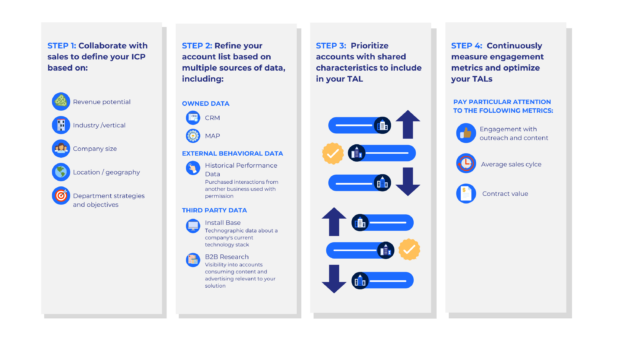
How to Build Target Account Lists with Audiences Ready to Engage or Buy

Wide-approach B2B marketing tactics revolve around aiming for the accounts you and your company think are a good fit. But tight budgets, limited resources, and longer, more complex sales cycles require you to work more efficiently.
Account-based marketing (ABM) takes a more strategic approach to audience targeting that uses data to move away from a generalized dream list of ideal clients to instead focus on the accounts ready to buy or engage. This data-informed list is your target account list—and it’s foundational to your ABM strategy’s success.
While named accounts from sales and your ideal customer profile (ICP) provide ample information to form your target account list, that list remains a fantasyland of possibilities. You need a combination of first- and third-party intent data to inform your targeting strategy and ensure you’re maximizing your ABM efforts by focusing on audience members that are truly ready to buy or engage.
When you learn how to build stronger target account lists with data, it leads to more urgent buyers, better conversion rates, and more actionable insights to further future success. Here’s how.
What Is a Target Account List?
A target account list (TAL) is a list of prioritized accounts that marketing and sales teams focus their efforts on that will yield high engagement, conversion, and return on investment (ROI). Companies without TALs risk falling into too wide of an approach in their brand and demand efforts, to the point where they waste resources and time on accounts that aren’t ready to engage.
Benefits of a Strong Target Account List
Target account lists set the stage for ABM efforts—after all, ABM is inherently about delivering a personalized approach based on buyer behaviors and engagement. Beyond being foundational to your marketing strategy, strong TALs benefit your company’s bottom line with more efficient marketing and sales workflows that move buyers through the sales funnel with more urgency and engagement.
Companies that build strong TALs notice the following benefits:
Stronger Alignment Between Sales and Marketing
The collaborative process of building and refining a target account list encourages a unified approach to goal-setting and strategy implementation. Strong sales and marketing alignment ensures that both teams are also leveraging their collective strengths more effectively and providing insights around account behavior and engagement, which leads to a more cohesive customer acquisition and retention strategy.
Increased Efficiency in Marketing Efforts for Better Personalization
Tailoring your outreach to the unique needs and challenges of each account on your TAL, your messaging resonates more deeply, fostering a connection that generic campaigns can seldom achieve.
Target account lists require data around the account, which is made up of an average of six buying committee members. You need to understand “who” these decision-makers are. You’ll look at data ranging from their demographic details (like job description and industry) to their intent data—their “why” for being interested in your product or service. With that information, you can then create nurture paths that clearly educate each of these stakeholders about your product and engage them by speaking directly to their concerns. The messaging ultimately resonates across the account, and pushes them through the sales funnel.
Increased Engagement and Conversion Rates
The relevance of your content and messaging is key to providing a superior customer experience along the buyer’s journey. As marketing campaigns and sales outreach enforce personalized nurture paths and continue to provide relevant content that speaks to your target accounts, you build trust faster between your organization and the account. When sales reps know more about buyer behavior and concerns, they can customize their approach to further convey the company’s expertise within their industry once the sales call happens, leading to more personalized meetings that result in higher engagement and conversion rates.
Better Retention Rates
The effects of a strong target account list go beyond the sales funnel. Once an account converts into a customer, you can continue to build the relationship through relevant messaging about product developments and industry trends that continue to position your company as a premium partner of choice. This content fosters a strong sense of your brand as it continues to grow and enforces engagement with accounts who will be excited to continue growing with your company and taking advantage of the upsell and cross-sell opportunities you have to offer.
4 Steps to Build a Target Account List that Prioritizes the Right Buyers
Creating a target account list isn’t as easy as simply listing businesses and top executives to contact. You need to carefully ideate who these accounts are, confirm the list with insights from your data sets and sales team, and then continuously refine and optimize the list based on deeper insights around your campaigns and sales interactions. Here’s how to ensure you seamlessly create a target account list with the right buyers in mind to execute campaigns with ease.

Step 1: Collaborate with Sales to Create an Ideal Customer Profile (ICP) and Lead Scoring System
The data in your customer relationship manager (CRM) and marketing automation platform (MAP) provides an ample platform for both sales and marketing teams to determine which accounts to target. The marketing team and sales reps need to bring these data sets together to determine a strong target account list that doesn’t just fill the pipeline, but satisfies the metrics of success that matter to the company at large.
Look at your pipeline and closed deals to identify any commonalities between prospects and customers. Utilize first-party data available in your CRM and marketing automation system to identify shared characteristics among high-value accounts. These lookalike target accounts, made from data around current customers, provide deeper insight into your ideal customer profile (ICP), as well as an opportunity to build a predictive and intent-based scoring system that you can apply to future TALs as you continue to refine your targeting efforts. This scoring system also provides information around account characteristics that will qualify or disqualify an account, which makes the selection process easier for sales outreach and marketing efforts. For example, if your product is meant for B2B businesses, it doesn’t make sense to target an account in the B2C eCommerce space that doesn’t follow B2B practices.
The more insights you can use to build an ICP, the more you’ll understand how to successfully target and sell to these accounts. Share your ICP with stakeholders across the company. Your finance and operations teams notice patterns across customer spend and product utility that will allow you to refine your TAL even further to identify which accounts are ready to buy your offering.
Step 2: Segment TAL through Data-Driven Insights
There are no restrictions on the size of your TALs—the larger the TAL, the greater the budget and potential impact. But you still want to identify the accounts showing the highest purchase intent while laying the groundwork for a more nuanced, impactful, and ultimately successful engagement strategy with your target accounts. Use a combination of your own first-party data along with third-party intent data and external behavioral data to help to identify and prioritize the accounts showing the highest purchase propensity. These sources include:
- Technographic data: Identifies the technology stack accounts are currently using
- B2B research data: Insight into the content and advertising accounts are consuming relevant to your solution
- Historical performance data: Purchased data that uncovers behavioral insights from key members of buying committees engaging with other businesses used with permission
Think of segmentation as peeling back the layers of your data to reveal the distinct subsets within your TAL. Consider segmenting by:
- industry-specific challenges they face
- patterns in product usage
- standout metrics in engagement levels
- notable trends in purchase history
- their preferred content types and channels of engagement
Segmentation further assists in another part of a successful ABM strategy: to deliver the right message to the right person at the right time. Personalization considers what channels these messages will most likely be seen on and garner engagement. Creating segments of your TAL and identifying the best nurture path for them allows you to deeply understand how a campaign serves their interests and increases the probability of engagement.
Step 3: Prioritize Accounts with Shared Characteristics
After establishing a deeply segmented target account list, the crucial next step is to prioritize these accounts based on shared characteristics that signal a higher readiness or propensity to engage and convert. This stage is about discerning which accounts, within the granular segments you’ve created, stand out due to specific, compelling attributes.
These characteristics might include a demonstrated urgency for your solutions, a pattern of active engagement with your digital content, or notable organizational changes that traditionally lead to a need for your products or services.
Consider an account that has consistently interacted with high-intent content on your website or one that has reached out with inquiries that match closely with your offering’s unique value proposition. Such behaviors are strong indicators of an account’s readiness to take the next step in the buyer’s journey. Additionally, external factors, like market expansions or shifts in executive leadership, can also signal an opportune moment for engagement, as these changes often come with new strategic priorities and budget allocations.
Prioritizing accounts with shared characteristics allows for a more strategic allocation of your marketing and sales resources. These are the accounts that you are most likely capable of successfully moving through the funnel with more urgency due to identifying their immediate needs and market/product fit, which enhances the effectiveness and efficiency of your messaging and outreach strategies.
Prioritization is a dynamic process, relying on continuous monitoring and analysis of account behaviors and market signals. By staying attuned to these factors, sales and marketing teams can adapt their strategies in real-time, ensuring that they are always engaging with the most promising prospects at the optimal moment.
Step 4: Measure Engagement and Optimize TAL
Just as accounts can shift in priority and campaign goals change alongside company goals, a strong, dynamic target account list always needs refinement. You need to diligently measure engagement metrics, which illuminate the effectiveness of your interactions with each account and optimize your TALs for future campaigns to continuously set each campaign up for success.
Pay particular attention to the following metrics:
- Engagement with outreach and content: Track key engagement indicators such as the frequency of website visits, depth of content engagement, and responsiveness to emails. These metrics serve as a litmus test for gauging the resonance of your outreach efforts and the readiness of accounts to progress further down the sales funnel.
- Average sales cycle: One marker of a successful ABM strategy is a shorter sales cycle, which indicates that accounts are responding and acting with more urgency to your messaging and campaign collateral.
- Contract value: ABM focuses on the relationship building between a brand and its audience. As personalization efforts resonate with accounts, they see the value of your product—and will pay premium costs for it. Track contract value (both the dollar amount and term) to see how much commitment accounts make once they convert. If numbers are not rising, look at your technographic and firmographic data, alongside market conditions, to consider market–product fit and anticipate any impacts they may have on pipeline goals and the company’s overall revenue goals.
As you sift through these metrics and other data sets, you want to uncover actionable insights and create a continuous cycle of optimization. For instance, an uptick in content downloads or webinar participation from a particular segment signals a growing interest that might warrant more personalized follow-up actions. Conversely, a dip in engagement metrics might indicate the need for a revised approach or message recalibration to better align with the evolving interests and needs of your target accounts.
Optimization allows you ample opportunities to fine-tune your ICP, recalibrate your lead scoring system, and, if necessary, redefine your market segments to ensure your TAL remains aligned with the most promising prospects. You want to create a targeting strategy that’s proactive, meaning you can leverage your qualification processes efficiently and use any predictive analytics to anticipate shifts in account behavior or market trends, thereby keeping your strategies one step ahead.
Each cycle of measurement and optimization refines your approach, enhancing the precision of your targeting and the impact of your marketing and sales efforts. Through this ongoing commitment to optimization, your TAL becomes not just a list, but a strategic asset that evolves in lockstep with your business objectives and market opportunities.
Create Target Account Lists with Quality Insights from ML Insights
Identifying your best-fit accounts for successful target account lists takes time and resources—but is immensely worth it for every campaign. The process of building your TAL dramatically transforms the precision and effectiveness of your outreach strategies. But if you don’t have quality data or insights to build that list, you lose out on the very foundation of ABM.
ML Insights integrates your CRM and MAP source systems with real-time intent data from over 20 million companies—including our proprietary historical performance data—so that you can quickly identify your target accounts, build your target account list, and determine what content and messaging will speak to their needs—all from one holistic platform. This allows you to focus more of your resources on creating dynamic campaigns versus sifting through multiple sources of data to determine your audience.
Ready to spend more time talking to your target accounts versus dreaming about who they are? Request a demo to learn more about ML Insights today. And once you have your target account list ready to go, learn how to get the most out of your ABM strategy with the Full-Funnel ABM Playbook.

